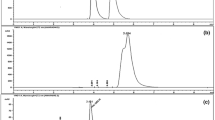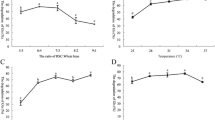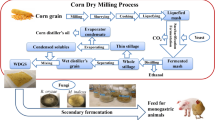Abstract
Purpose
Edible oil industries are shifting to the increased production of cold pressed oils in order to preserve some of the vital nutrients in the oil. Consequently, the seed cake residue would lack significant nutrients that are otherwise retained in the oils, thus making the quality of residue inferior when applied as a cattle feed.
Methods
In this study, Mustard Oil Seed Cake (MOSC) was employed as a substrate to enhance the feed quality using koji strains namely Aspergillus oryzae and Aspergillus niger separately and suitable process parameters such as solid to liquid ratio, pH, incubation time and inoculum quantity were optimized for the maximum nutritive enhancement of cold pressed MOSC. Changes in the physico-chemical properties were analyzed by SEM, EDS and FTIR along with feed functional properties to analyze the quality.
Results
Free Amino Acid (FAA) and Reducing Sugar (RS) were chosen as a critical indicators of enrichment. A. oryzae resulted in 20.74-fold and 19.07-fold increase in FAA and RS respectively, whereas, A. niger showed 13.24-fold and 3.04-fold increase. Critical parameters such as solid to liquid ratio, pH, incubation time and inoculum volume were selected. Briquetting resulted in efficient mycelia coverage as evident from SEM images and the EDS analysis indicated the enhancement of the essential elements in the MOSC and also the functional properties after fermentation indicated an effective biotransformation of MOSC.
Conclusion
These fermented MOSC can be applied as potent cattle feed thereby adding value to this agro industrial waste by establishing effective solid state fermentation strategy.
Graphic Abstract







Similar content being viewed by others
Data Availability
Specific subset of data to depict the briquetting flow chart and SEM-EDS analysis table provided as the supplementary material.
References
Randolph, T.F., Schelling, E., Grace, D., Nicholson, C.F., Leroy, J.L., Cole, D.C., Demment, M.W., Omore, A., Zinsstag, J., Ruel, M.: Role of livestock in human nutrition and health for poverty reduction in developing countries. J. Anim. Sci. (2007). https://doi.org/10.2527/jas.2007-0467
Gupta, S.: Dairy industries in India: technological implementation and challenges. https://www.semanticscholar.org/paper/Dairy-Industries-in-India%3A-Technological-and-Gupta/e88acdb4b5c855621c0d06c62ca5235d0fc82205 (2017). Accessed 10 May 2020
Swati Sehwag, S., Das, M.: A brief overview: present status on utilization of mustard oil and cake. Indian J. Tradit. Knowl. 14, 244–250 (2015)
Sharma, V.P.: Overview of oilseeds sector: current status and growth behaviour. In: Oilseed production in India: The problems and prospects, pp. 17–25. Springer, India (2017)
Kumar, S.P.J., Prasad, S.R., Banerjee, R., Agarwal, D.K., Kulkarni, K.S., Ramesh, K.V.: Green solvents and technologies for oil extraction from oilseeds. Chem. Cent. J. (2017). https://doi.org/10.1186/s13065-017-0238-8
Çakaloğlu, B., Özyurt, V.H., Ötleş, S.: Cold press in oil extraction. A review. Ukr. Food J. (2018). https://doi.org/10.24263/2304
Chang, P.K., Horn, B.W., Abe, K., Gomi, K.: Aspergillus. In: Carl, A.B., Mary, L.T. (eds.) Encyclopedia of food microbiology, pp. 77–82. Elsevier, Amsterdam (2014). https://doi.org/10.1016/b978-0-12-384730-0.00010-0
Aidoo, K.E., Smith, J.E., Wood, B.J.B.: Industrial aspects of soy sauce fermentations using Aspergillus. In: Powell, K.A., Renwick, A., Peberdy, J.F. (eds.) The genus Aspergillus: from taxonomy and genetics to industrial application, pp. 155–169. Plenum Press, New York (1994)
Chou, C.C., Rwan, J.H.: Mycelial propagation and enzyme production in koji prepared with Aspergillus oryzae on various rice extrudates and steamed rice. J. Ferment. Bioeng. (1995). https://doi.org/10.1016/0922-338X(95)91273-8
Trucksess, M.W., Flood, M.T., Mossoba, M.M., Page, S.W.: High-performance thin-layer chromatographic determination of deoxynivalenol, fusarenon-X, and nivalenol in barley, corn, and wheat. J. Agric. Food Chem. (1987). https://doi.org/10.1021/jf00076a001
Xu, J., Jin, F., Hao, J., Regenstein, J.M., Wang, F.: Preparation of soy sauce by walnut meal fermentation: composition, antioxidant properties, and angiotensin-converting enzyme inhibitory activities. Food Sci. Nutr. (2020). https://doi.org/10.1002/fsn3.1453
Yuan, J., Zhing, W., Jin, Y., Lin, C., Kang, X., Deng, C.: Fermentation technology and quality of sauce prepared from rice dreg protein. J. Inst. Brew. (2015). https://doi.org/10.1002/jib.241
Kim, J., Yi, Y.: pH, acidity, color, amino acids, reducing sugars, total sugars, and alcohol in puffed millet powder containing millet takju during fermentation. Korean J. Food Sci. Technol. 42, 727–732 (2010)
Hessle, A.K., Eriksson, M., Nadeau, E., Turner, T., Johansson, B.: Cold-pressed hempseed cake as a protein feed for growing cattle. Acta Agric. Scand Sect. A (2008). https://doi.org/10.1080/09064700802452192
Manan, M.A., Webb, C.: Design aspects of solid state fermentation as applied to microbial bioprocessing. J. Appl. Biotechnol. Bioeng. 4(1), 511–532 (2017). https://doi.org/10.15406/jabb.2017.04.00094
Hedge, J.E., Hofreiter, B.T.: Carbohydrate chemistry 17. In: Whistler, R.L., Be Miller, J.N. (eds.) Academic Press. New York (1962)
Miller, G.L.: Use of dinitrosalicylic acid reagent for determination of reducing sugars. J. Anal. Chem. (1972). https://doi.org/10.1021/ac60147a030
Lowry, O.H., Rosebrough, N.J., Farr, A.L., Randall, R.J.: Protein measurement with the Folin phenol reagent. J. Biol. Chem. 193, 265–275 (1951)
Balasubramanian, T., Sadasivam, S.: Changes in starch, oil, protein and amino acids in developing seeds of okra (Abelmoschus esculentus L. Moench). Plant Food Hum. Nutr. (1987). https://doi.org/10.1007/BF01092299
Sadh, P.K., Chawla, P., Bhandari, L., Duhan, J.S.: Bio-enrichment of functional properties of peanut oil cakes by solid state fermentation using Aspergillus oryzae. J. Food Meas. Charact. (2017). https://doi.org/10.1007/s11694-017-9675-2
Sharif, R.H., Paul, R.K., Bhattacharjya, D.K., Ahmed, K.U.: Physicochemical characters of oilseeds from selected mustard genotypes. J. Bangladesh Agric. Univ. 15, 27–40 (2017)
Siger, A., Kalucka, M.N., Szczapa, E.L.: The content and antioxidant activity of phenolic compounds in cold-pressed plant oils. J. Food Lipids (2008). https://doi.org/10.1111/j.1745-4522.2007.00107.x
Kung, L., Rode, L.M.: Amino acid metabolism in ruminants. Anim. Feed Sci. Technol. 59, 167–172 (1996)
Palukurty, A., Somalanka, S.R.: Optimization of nutritional parameters for production of alpha amylase using Aspergillus oryzae MTCC 3017 by central composite design. Int. J. Ind. Biotechnol. Biomaterial. (2016). https://doi.org/10.13140/RG.2.1.4326.5520
Mrudula, S., Murugammal, R.: Production of cellulase by Aspergillus niger under submerged and solid state fermentation using coir waste as a substrate. Braz. J. Microbiol. (2011). https://doi.org/10.1590/S1517-83822011000300033
Puri, S., Arora, M., Sarao, L.: Production and optimization of amylase and glucoamylase using Aspergillus oryzae under solid state fermentation. Int. J. Res. Pure Appl. Microbiol. 3, 83–88 (2013)
Tudor, D., Robinson, S.C., Cooper, P.A.: The influence of moisture content variation on fungal pigment formation in spalted wood. AMB Express (2012). https://doi.org/10.1186/2191-0855-2-69
Abubakar, A., Suberu, H.A., Bello, I.M., Abdulkadir, R., Daudu, O.A., Lateef, A.A.: Effect of pH on mycelial growth and sporulation of Aspergillus parasiticus. J. Plant Sci. 1, 64–67 (2013)
Lahouar, A., Marin, S., Sempere, A.C., Saïd, S., Sanchis, V.: Effects of temperature, water activity and incubation time on fungal growth and aflatoxin B1 production by toxinogenic Aspergillus flavus isolates on sorghum seeds. Rev. Argent. Microbiol. (2016). https://doi.org/10.1016/j.ram.2015.10.001
Purohit, C., Rajyalakshmi, P.: Quality of products containing defatted groundnut cake flour. Int. J. Food Sci. Technol. (2011). https://doi.org/10.1007/s13197-010-0125-y
Elkhalifaa, A.E.O., Schiffler, B., Bernhardt, R.: Effect of fermentation on the functional properties of sorghum flour. Food Chem. (2005). https://doi.org/10.1016/j.foodchem.2004.05.058
Aryee, A.N.A., Agyei, D., Udenigwe, C.C.: Impact of processing on the chemistry and functionality of food proteins. In: Yada, R.Y. (ed.) Proteins in food processing, 2nd edn., pp. 27–45. Woodhead Publishing Series in Food Science, Techonologya and Nutrition, Cambridge (2018)
McDowell, L.R.: Feeding minerals to cattle on pasture. Anim. Feed Sci. Technol. (1996). https://doi.org/10.1016/0377-8401(96)00983-2
Spears, J.W.: Nickel as a “Newer Trace Element” in the nutrition of domestic animals. J. Anim. Sci. (1984). https://doi.org/10.2527/jas1984.593823x
Allen, V.G.: Influence of dietary aluminum on nutrient utilization in ruminants. J. Anim. Sci. 59, 836–844 (1984)
Shi, C., He, J., Yu, J., Yu, B., Huang, Z., Mao, X., Zheng, P., Chen, D.: Solid state fermentation of rapeseed cake with Aspergillus niger for degrading glucosinolates and upgrading nutritional value. J. Anim. Sci. Biotechnol. (2015). https://doi.org/10.1186/s40104-015-0015-2
Volli, V., Singh, R.K.: Production of bio-oil from de-oiled cakes by thermal pyrolysis. Fuel (2012). https://doi.org/10.1016/j.fuel.2012.01.016
Olukomaiya, O., Fernando, C., Mereddy, R., Li, X., Sultanbawa, Y.: Solid-state fermented plant protein sources in the diets of broiler chickens: a review. Anim. Nutr. (2019). https://doi.org/10.1016/j.aninu.2019.05.005
Knudson, L.: Tannic acid fermentation. J. Biol. Chem. 14, 159–184 (1913)
Sharath, B.S., Mohankumar, B.V., Somashekar, D.: Bio-detoxification of phorbol esters and other anti-nutrients of Jatropha curcas seed cake by fungal cultures using solid-state fermentation. Appl. Biochem. Biotechnol. (2014). https://doi.org/10.1007/s12010-013-0698-9
Woldman, Y., Appling, D.R.: A general method for determining the contribution of split pathways in metabolite production in the yeast Saccharomyces cerevisiae. Metab. Eng. 4, 170–181 (2002). https://doi.org/10.1006/mben.2001.0221
Oikawa T (2006) Alanine, aspartate, and asparagine metabolism in microorganisms. In: Amino Acid Biosynthesis-Pathways, Regulation and Metabolic Engineering, Springer, Berlin, Germany, Heidelberg pp. 273-288
Line, R.N., Marianne, N.L., Michael, J.D., Jacob, H.N., Soren, B.N.: Effect of free cysteine on the denaturation and aggregation of holo α-lactalbumin. Int. Dairy J. 79, 52–61 (2018). https://doi.org/10.1016/j.idairyj.2017.11.014
Ko, B.K., Ahn, H.J., van den Berg, F., Lee, C.H., Hong, Y.S.: Metabolomic insight into soy sauce through 1H NMR spectroscopy. J. Agric. Food Chem. 57, 6862–6870 (2009). https://doi.org/10.1021/jf901454j
Ahluwalia, S., Bidlan, R., Shrivastav, A.K., Goswami, R.K., Singh, P., Sharma, J.G.: Optimization of protein extraction from detoxified Jatropha seed cake using response surface methodology and amino acid analysis. Int. J. Environ. Sci. Technol. 17, 1087–1100 (2020). https://doi.org/10.1007/s13762-019-02340-4
Sarker, A.K., Saha, D., Begum, H., Zaman, A., Rahman, M.M.: Comparison of cake compositions, pepsin digestibility and amino acids concentration of proteins isolated from black mustard and yellow mustard cakes. AMB Express (2015). https://doi.org/10.1186/s13568-015-0110-y
Karau, A., Grayson, I.: Amino acids in human and animal nutrition. Adv. Biochem. Eng. Biotechnol. (2014). https://doi.org/10.1007/10_2014_269
Acknowledgements
The authors would like to acknowledge the Department of Biotechnology, School of Bioengineering, SRM Institute of Science and Technology, Kattankulathur, Tamil Nadu India for providing necessary infrastructure facilities to carry out the research work.
Funding
No external funding/grants are associated with this work.
Author information
Authors and Affiliations
Contributions
This research work has been completed with the equal contribution from the authors DC, NS, PA and RD along with drafting of this manuscript. The functional property analysis of the fermented oil seed cakes was carried out by the AS. SJ is responsible for designing of the work and evaluation of the results and correcting the manuscript.
Corresponding author
Ethics declarations
Conflict of interest
This article is an original research work designed and executed by the authors. There is no conflict of interest associated with this scientific work.
Consent for Publication
The authors mutually agree to publish this scientific work carried out by them to this journal.
Consent for Participate
The authors have consented to participate in the research work carried and publish the technical outcome of the same.
Additional information
Publisher's Note
Springer Nature remains neutral with regard to jurisdictional claims in published maps and institutional affiliations.
Supplementary Information
Below is the link to the electronic supplementary material.
Rights and permissions
About this article
Cite this article
Chakraborty, D., Sarkar, N., Agrahari, P. et al. Strategic Nutrient Enhancement of Mustard Oil Seed Cake by Briquetting and Koji Fermentation for Ruminants Feed. Waste Biomass Valor 13, 1207–1221 (2022). https://doi.org/10.1007/s12649-021-01570-3
Received:
Accepted:
Published:
Issue Date:
DOI: https://doi.org/10.1007/s12649-021-01570-3




